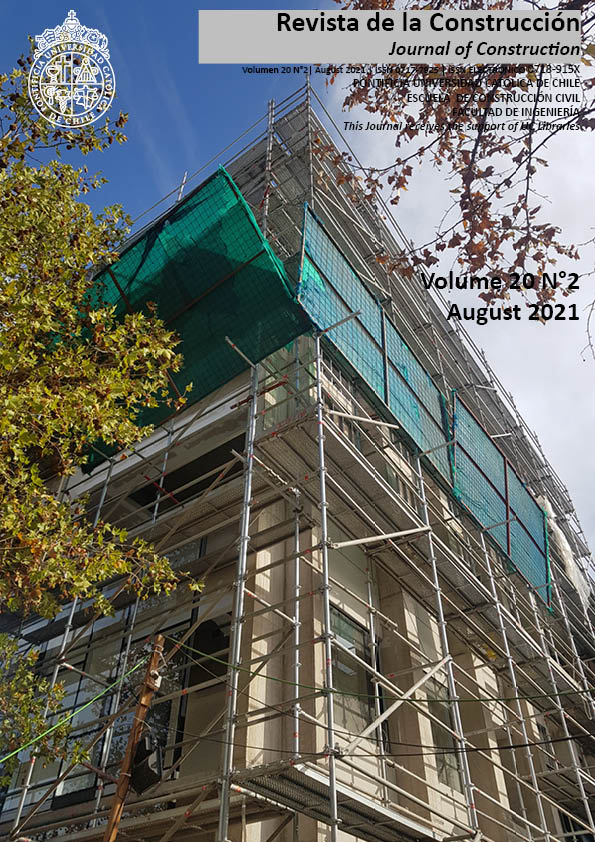Frictional properties between geocells filled with granular material
DOI:
https://doi.org/10.7764/RDLC.20.2.332Keywords:
geocell, granular material, interface interaction, normal stress, shear stressAbstract
The parameters concerning the interaction between geocell and granular materials is required for the design of many geotechnical structures. With this in mind, a series of experiments using simple direct shear tests are conducted in order to understand the frictional properties between geocells filled with granular materials. The 54 test samples are prepared by filling the geocell with granular materials having three different gradations. These samples are tested at three different relative densities under three different normal stress levels. As a result, it was observed that interface resistance between the geocells filled with granular material is found to be generally greater than in the samples without geocells. Additionally, these samples with geocells are found to be stiffer; this is due to the fact that the samples with geocell gained more cohesion because geocells confined the grains within a restricted volume.
Downloads
References
Altay, G., Kayadelen, C., Taşkıran T., & Kaya Y. Z. (2019). A laboratory study on pull-out resistance of geogrid in clay soil. Measurement 139 301–307.
Anubhav, & Basudhar, P.K. (2010). Modeling of soil-woven geotextile interface behavior from direct shear test results. Geotext. Geomembranes 28 (4), 403–408.
ASTM D3080-04. (2004). Standard Test Method for Direct Shear Test of Soils Under Consolidated Drained Conditions, ASTM International, West Conshohocken, PA.
ASTM D 6913-04. (2004). Standard Test Methods for Particle-Size Distribution (Gradation) of Soils Using Sieve Analysis1.
Brown, S.F., Kwan, J., & Thom, N.H. (2007). Identifying the key parameters that influence geogrid reinforcement of railway ballast. Geotext. Geomembranes 25(6), 326–335.
Chen, R.H., Huang, Y.W., & Huang, F.C. (2013). Confinement effect of Geocells on sand samples under triaxial compression. Geotext. Geomembranes 37, 35–44.
Cuelho, E., Perkins, S., & Morris, Z. (2014). Relative Operational Performance of Geosynthetic Used as Subgrade Stabilization. Final Project Report, FHWA/MT-14-002/7712-251, Research Programs. State of Montana Department of Transportation, Montana, USA.
Canakci, H., Hamed, M., Celik, F., Sidik, W., & Eviz, F. (2016). Friction characteristics of organic soil with construction materials. Soils and Foundations, 56(6), 965-972.
Dash, S.K., & Chandra, B.M. (2013). Improved performance of soft clay foundations using stone columns and Geocell-sand mattress. Geotext. Geomembranes 41, 26–35.
Dash, S.K., Rajagopal, K., & Krishnaswamy, N.R. (2007). Behaviour of geocell reinforced sand beds under strip loading. Can. Geotech. J. 44(7), 905–916
Ferreira, F.B., Vieira, C.S., & Lopes, M.L. (2015). Direct shear behaviour of residual soil-geosynthetic interfaces – influence of soil moisture content, soil density and geosynthetic type. geosynthetics Int 22(3), 257–272.
Góngora, I.A.M.G., & Palmeira, E.M. (2016). Assessing the influence of some soil-reinforcement interaction parameters on the performance of a low fll on compressible subgrade. Part II: influence of surface maintenance. Int. J. Geosynthet. Ground Eng. 2(1), 18–29.
Hatami, K., & Esmaili, D. (2015). Unsaturated soil–woven geotextile interface strength properties from small-scale pullout and interface tests. Geosynth. Int. 22(2), 161–172.
Huang, C.C. (2014). Force equilibrium-based finite displacement analyses for reinforced slopes: formulation and verification. Geotext. Geomembranes 42(4), 394–404.
Kayadelen, C., Önal, T.Ö., & Altay, G. (2018). Experimental study on pull-out response of geogrid embedded in sand. Measurement 117, 390–396.
Khoury, C.N., Miller, G.A., & Hatami, K. (2011). Unsaturated soil– geotextile interface behavior. Geotext. Geomembranes 29(1), 17–28.
Latha, G.M., & Murthy, V.S. (2007). Effects of reinforcement from on the behavior of geosynthetic reinforced sand. Geotextiles and Geomembranes 25, 23–32.
Latha, G.M., Rajagopal, K., & Krishnaswamy, N.R. (2006). Experimental and theoretical investigations on geocell-supported embankments. International Journal of Geomechanics 6(1), 30–35.
Leshchinsky, B., & Ling, H. (2013). Effects of Geocell confinement on strength and deformation behaviour of gravel. J. Geotech. Geoenviron. Eng. 139 (2), 340–352.
Liu, S.Y., Han, J., Zhang, D.W., & Hong, Z.S. (2008). A combined DJM-PVD method for soft ground improvement. Geosynthetics International 15(1), 43–54.
Manju, G.S., & Madhavi Latha, G. (2013). Interfacial friction properties of Geocell reinforced sand. International Journal of Innovative Research in Science, Engineering and Technology 2(1), 25–31.
Moghaddas Tafreshi, S.N., & Dawson, A.R. (2010). Comparison of bearing capacity of a strip footing on sand with geocell and with planar forms of geotextile reinforcement. Geotext. Geomembranes 28(1), 72–84.
Oh, I. Y. & Shin, E. C. (2007). Reinforcement and Arching Effect of Geogrid Reinforced and Pile-Supported Embankment on Marine Soft Ground. Marine Georesources and Geotechnology, 25(2), 97-118.
Sitharam, G., Sireesh, S., & Dash, S.K. (2007). Performance of surface footing on geocellreinforced soft clay beds. Geotech. Geol. Eng. 25(5), 509–524.
Song, F., Xie, Y.L., Yang, Y.F., & Yang, X.H. (2014). Analysis of failure of flexible Geocellreinforced retaining walls. Geosynth. Int. 21(6), 342–351.
Takegawa, N., Sawada, & Y., Kawabata, T. (2019). Geogrid-based countermeasures against scour behind coastal dikes under tsunami overflow. Marine Georesources & Geotechnology.
Tanyu, B.F., Aydilek, A.H., Lau, A.W., Edil, T.B., & Benson, C.H. (2013). Laboratory evaluation of Geocell-reinforced gravel subbase over poor subgrades. Geosynth. Int. 20(2), 47–61.
Tavakoli Mehrjardi, Gh, Moghaddas Tafreshi, S.N., & Dawson, A.R. (2012). Combined use of Geocell reinforcement and rubber–soil mixtures to improve performance of buried pipes. Geotext. Geomembranes 34, 116–130.
Tavakoli Mehrjardi, Gh, & Motarjemi, F. (2018). Interfacial properties of Geocell-reinforced granular soils. Geotext. Geomembranes 46(4), 384–395.
Thakur, J., Han, J., & Parsons, R. (2016). Factors influencing deformations of geocell reinforced recycled asphalt pavement bases under cyclic loading. J. Mater. Civ. Eng. 29(3), 1–12.
Vieira, C.S., Lopes, M.L., & Caldeira, L.M. (2013). Sand-geotextile interface characterisation through monotonic and cyclic direct shear tests. geosynthetics Int 20(1), 26–38.
Wang, Y., Chen, Y., & Liu, W. (2008). Large-scale direct shear testing of Geocell reinforced soil. J. Cent. South Univ. Technol 15, 895–900.
Yang, X., Han, J., Pokharel, S.K., Manandhar, C., Parsons, R.L., Leshchinsky, D., & Halahmi, I. (2012). Accelerated pavement testing of unpaved roads with geocell-reinforced sand bases. Geotext. Geomembranes 32, 95–103.
Zhang, M.X., Javadi, A.A., & Min, X. (2006). Triaxial tests of sand reinforced with 3D inclusions. Geotext. Geomembranes 24(4), 201–209.
Zhou, H.B., & Wen, X.J. (2008). Model studies on geogrid- or geocell-reinforced sand mattress on soft soil. Geotextile and Geomembranes 26, 231–238.








